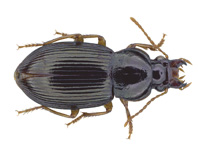Abstract
Among insects, Orthoptera are a group famous for communicating by sound. This is especially true for bush-crickets (or katydids; Tettigonioidea). All acoustically active species produce sound by rubbing the fore wings (tegmina) against each other, using a stridulatory file situated on the lower side of the left tegmen and a scraper formed by the inner edge of the right tegmen (see e.g., Ragge & Reynolds 1998). Bush-cricket species of the tribe Acrometopini often have complicated stridulatory files and also complex songs, as shown in a recent study (Hemp et al. 2017). During the preparation of that paper we discovered a sound record of a species of the group taken on 16th March 1972 by the entomologist David Hollis in Angola as part of the multi-disciplinary entomological South Western Africa Expedition (for more details see Lane et al. 2011, Pethers 2016). Hollis (principally a hemipterist) published several papers on different groups of insects (see http://bionames.org/authors/David%20Hollis; incomplete), including Orthoptera (see Ingrisch & Willemse 2004). The sound recording was deposited in the British Museum (Natural History) Library of Recorded Insect Sounds, and was later made openly accessible in the BioAcoustica repository (Baker et al. 2015). Hollis had found the animal at light, recorded it on the same day singing on a bush, and brought the specimen (together with two conspecific males) to the Natural History Museum (NHM), London. Here it was later identified as Horatosphaga ?stuhlmanni (Karsch 1896) by D. Ragge, the curator of Orthoptera at the NHM at that time. Under this name (Horatosphaga ?stuhlmanni) the song was described in Hemp et al. 2017. Horatosphaga males are fully winged while females are flightless and plump; sexual dimorphism reaches its extreme form in this group of species. Species of this genus are mostly recorded from open grasslands in savanna habitats up to montane elevations (e.g. H. heteromorpha, Hemp 2013).
References
Baker, E., Price, B.W., Rycroft, S.D., Hill. J. & Smith, V.S. (2015) BioAcoustica: A free and open repository and analysis platform for bioacoustics. Database, 2015, bav054.
https://doi.org/10.1093/database/bav054Hemp, C. (2013) Annotated list of Ensifera (Orthoptera) and further records on Caelifera (Orthoptera) of Mt Kilimanjaro, Tanzania. Zootaxa, 3613 (4), 301–342.
https://doi.org/10.11646/zootaxa.3613.4.1Hemp, C., Heller, K.-G., Warchałowska-Śliwa, E., Grzywacz,B. & Hemp,A. (2017) New genera and new species of Acrometopini (Orthoptera: Tettigonioidea Phaneropterinae) from East Africa and a review of all known stridulatory organs, songs and karyotypes of the tribe. Insect Systematics & Evolution. [accepted]
Ingrisch, S. & Willemse, F. (2004) Bibliographia Systematica Orthopterorum Saltatoriorum: systematic bibliography of saltatorial Orthoptera from Linnaean times to the end of the 20th century (about 1750 to 2000). Pensoft Publishers, Sofia & Moscow, 536pp.
Karsch, F. (1896) Neue Orthopteren aus dem tropischen Afrika. Stettiner Entomologische Zeitung, 57, 242–359.
La Baume, W. (1911) Beitrag zur Kenntnis des aethiopischen Orthopteren. Stettiner Entomologische Zeitung, 72, 308–326.
Lane, R.P., Blackman, R.L., Cogan, B.H., Cogan, C., Cranston, P.S., Crosskey, R.W., Hammond, P.M., Hollis, D., Hutson, A.M., Mound, L.A., Pont, A.C., Sattler, K.S.O., Tremewan, W.G. & Vane-Wright, R.I. (2011) An appreciation of Paul Freeman DSc, ARCS, Hon FRES (26.v.1916–31.vii.2010), with a bibliography of his published entomological works [including contributions by Thompson, F.C. & Vane-Wright, R.I., Bibliography: the entomological publications of Paul Freeman, pp. 11–14; and Evans, G., For Grandpa, p. 15]. Antenna, 35, 5–15.
Pethers, H. (2016) The Museum ‘homemade’ mobile field laboratory. Natural History Museum Blogs. Available from: https://blog.nhm.ac.uk/2016/11/24/the-museum-homemade-mobile-field-laboratory-explore-your-archive-week-library-and-archives/#more-6634 (accessed 29 May 2017)
Ragge, D.R. (1960) The Acrometopae of the Ethiopian Region: a revision, with notes on the sexual dimorphism shown by the group (Orthoptera: Tettigoniidae). Bulletin of the British Museum (Natural History), Entomology Series, 8, 269–333.
Ragge, D.R. & Reynolds, W.J. (1998) The songs of the grasshoppers and crickets of western Europe. Essex (Harley Books), Colchester, 591 pp.
Schaum, H. (1853) Ueber die von Peters mitgebrachten Orthoptera aus Mossambique. Uebersicht der von ihm in Mossambique beobachteten Orthopteren nebst Beschreibung der neu entdeckten Gattungen und Arten durch Herrn Dr Hermann Schaum. Bericht über die zur Bekanntmachung geeigneten Verhandlungen der Königlich Preussischen Akademie der Wissenschaften zu Berlin, 1853, 775–780.
Strand, E. (1911) Beschreibungen afrikanischer Lepidopteren insbesondere Striphnopterygiden. Annales de la Société entomologique de Belgique, 55, 145–164.
Stuke, J.-H. (2015) New Conopid records from the Afrotropical Region (Diptera). Part 1: Paramyopa Kröber, Pseudoconops Camras, Stylogaster Macquart, Thecophora Rondani, and Zodion Latreille. Zootaxa, 3963 (2), 101–159.
https://doi.org/10.11646/zootaxa.3963.2.1

